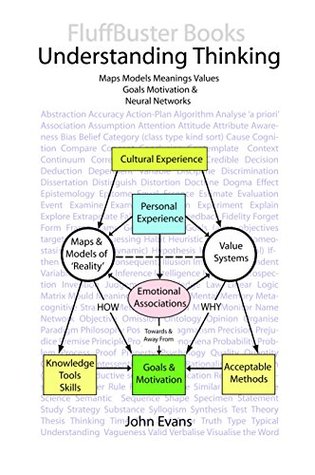Kindle Notes & Highlights
by
John Evans
Read between
June 22, 2018 - March 9, 2019
Copyright © John Evans 2018 John Evans has asserted his right under the Copyright, Designs and Patents Act 1988 to be identified as the author of this book.
Plato
ideals and
other more
luxurious priorities.
Sometimes it simply isn’t clear what to do, and then our default habitual interpretations and reactions kick in and run our behaviour.
The models are dynamic, giving rise to predictions, expectations, beliefs and values.
updating the deep foundations of well established models.
NLP (Neuro Linguistic Programming) has developed simple techniques for ‘rewriting your personal history’,
changing our understanding of that class of event and the emotions we have associated with it.
consciously examining our pre-conscious models.
am drawn to some elements and wish to avoid others.
The pre-conscious mind handles the orchestration of all these emotional vectors.
Accept the challenge but take careful accounts
of the risks. ‘Yes’ takes the helm while ‘no’ watches for danger from the crow’s nest.
The mind is its own place, and in itself, can make a Heaven of Hell, a Hell of Heaven. John Milton (1608–1674), Paradise Lost[7].
Towards and Away From.
prepared to do.
help us deal more effectively with different aspects of reality.
understand her model of the world, so I could see the world through her eyes.
Her decision making is fast because her business model is simple.
trusted crew of experts.
I certainly enjoy turning a profit by applying a bit of creative intelligence to practical problems,
I currently do not find it easy to trust lawyers, architects, builders, or the inner workings of the property market.
bound together in a mutually beneficial, long-term, open and trustworthy relationship
It is up to you.
Be realistic and then be flexible.
As is so often the case, new group-level properties emerge from the interaction of many individual components.
group’s perception and framing
main cause of inter-group conflict.
(win win),
But that is a big subject for another book.
The people around us appear to become even more like our opinion of them.
This has important implications for how we organise society.
Both groups think they are doing the right thing, given their models of reality.
Is there a more productive way to make sense of your personal and cultural experiences,
Only when the context is pinned down to a very specific time, place, and situation, can we say that something is good or bad in our value system.
design good useful productive new meanings that will work well for you, and for others, now and into the future.
Bias – a socially unacceptable level of perceptual distortion, predisposition, prejudice (pre-judgement).
Games – humans play lots of different thinking games.
It works in a way that complements what we know about how neural networks model our experience of the world.
Introspection – consciously looking inside, at our thoughts, emotions, reactions, historical decisions, internal dialogue, perceptual distortions, maps, models, values, goals, motivations, etc.
Meaning – a beneficial by-product of neural network perception based on detecting associations.
Paradigm (see game) - a socially agree set of rules for dealing with something (from Latin and Greek).
Prejudice - see bias.
Learning to ask questions is essential to thinking and understanding.
Reification – inventing and naming a concept or class and then treating it as if it is real.
Semantic – the meaning of words and language (Greek for meaning).
Synthesis (paired with analysis) - put it back together – the recombining of separate parts or elements to form a complex whole.
selecting packages of reactions.


